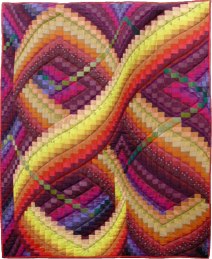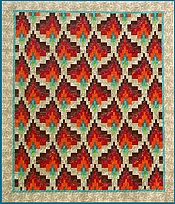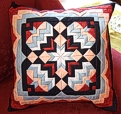For the very first time I had the chance to attend the Festival of Quilts in Birmingham this year. The last quilty event I attended in the UK was the National Patchwork Championships at Ascot in 1997, which is quite a long time ago. It felt good to be back at a quilt show, and I enjoyed every minute of my stay.
Since I returned home, I have also enjoyed myself studying the photos I took of the quilts. I had planned to post some of them soon after my return, but I have had a hard time choosing which ones, and where to start.
There was a large number of quilts on display, and even though I spent most of the time looking at the quilts, I am not sure I got to see all of them. And then there were all the boots, which also had quilts in them, along with other stuff.
What I found I admired most at the show was all the wonderful and detailed quilting done on most of the quilts that were shown. So I think that is where I will start.

“Rhapsody” by Sandy Chandler is one of the quilts that caught my attention. It is a wholecloth quilt, and was entered in the Traditional Quilts category, and got a “Highly Commended”, which is kind of a 4th place. It was quilted on a longarm machine, mostly hand guided.
Lots and lots of beautiful feather quilting. Click on the photos to see a larger and closer view.

This one, called “Sunshine and Flowers”, was made by the same person as the one above. It was entered in the Quilters’ Guild Challenge, which had a garden theme this year.
Again: Lots and lots of beautiful quilting.

Here is a little beauty: “After the Snowfall” by Sheena Norquay. It was entered in Pictorial Quilts, and was one of the Judges Choices.
I did not get to take many close ups of this one, but above are a couple.

This is “Lily White” by Pauline Tiney, entered in the Contemporary Quilts category. I came across this quilt one morning just before I was due at a workshop, so got just the one picture. It was hung so you could see both the back and the front, and I think this is the back side. It is still beautiful.
There were so many quilts I thought that I would go back to have a closer look at later, but in the end, there was not enough time.
The thing about wholecloth quilts is that they often don’t look like much until you go close and study them. That is also partly true for this one:

It is called “Simply Mandalas” and was made by Pierra Vernex from Canada. The motifs are inspired by circular mandala motifs made by Tibetan monks. It was made completely on a home sewing machine, using the quilt-as-you-go method.
It is truly stunning.

Here is one with more colours and beautiful quilting. It is called “Kutch Diamonds”, and was made by Annelize Littlefair. It was entered in the Traditional Quilt category, and got a Highly Commended. You can see why below:
It is freehand quilted on a longarm machine, and took 150 hours to finish. I can easily believe that.

This is called “The Old Garden Gate”, and is made by Lynda Jackson. It has been quilted on a longarm machine.
Below are some close ups:
Then there was this one:

It did not look like much at first glance, but the more I looked, the more it caught my interest.

I thought it was a bit fun that it was also captured with another head on it 😉
The quilt is called “Profiles”, and was made by Stephanie Pettengell. It was entered in the Art Quilt category.
The profiles were made by removing the black colour of the fabric, using discharge paste. It was then free machine quilted.
All the profiles were quilted in a similar manner, except the brains, they were all different.
After looking for a while, I also discovered that profiles were quilted into the black part of the fabric. A very original piece.
Since we are on the topic of heads, I will also show you this one:

This is “Skull Optics” by Paula Rafferty, entered in the Art Quilt category.
When I first came by it, I did not see the skull, – just the black and white stripes, which were kind of disturbing to the eyes. I took a photo anyway, because I thought the border was so neat.

Only after loading the photos on my home computer did I notice the skull motif.
On a more humorous note: The space in front of this one was always crowded.

It is a group quilt called “Les Q-Ers” entered by Marion Barlow on behalf of the group Q 4 Quilters. It shows a group of quilters in a bus queue, heading for a quilt show. The quilt got a Highly Commended.
And here is the reverse side, on their way back from the show.

I think I am the one who does not NEED more fabric, – except I do not have to hide it when I get home. 😉
Although I spent most of the time looking at quilts, I set aside a small amount of time at the end of the day to walk by the boots, – just to see what was there. Of course I got tempted, – and I also had a small list of items that I was looking out for.
Here is what I brought home:

The fabrics at the front are all for a project that is lurking in the wings. They are silks, some hand dyes, and a few gorgeous ones from Oakshott.
Then I was also tempted by Heide Stoll Weber’s hand dyed fabric packs, and I am really looking forward to make something out of the two pink and orange bundles to the right. I also grabbed some neutrals for my hexagon project, and threw in a few other fat quarters as well.
I bought one of the African embroideries, and a few of their prints. Then there is some bling and a small iron, and also thread and needles. I love the Nimble Thimbles, so bought a couple of those, and on the last day I splashed on a small hand made pair of scissors. (I bought a pair of hand made duck billed scissors at Ascot nearly twenty years ago, and they are still very good, so I reckon it is worth the expense. ) They must be very popular, for as I was getting the last pair, I overheard them saying they were super busy and would not be taking any new orders till after Christmas.
The fabrics have been duly fondled and put away till I have finished my current project. In between sewing, there are plenty more photos to be studied, and I will pick out some more to show you in another post.
🙂
Eldrid
Filed under: patchwork, quilt, quilt show, quilting, sewing, textiles, travel | Tagged: Art quilts, Contemporary quilts, fabric, Group quilts, patchwork, Pictorial Quilts, quilt, quilt show, quilting, thread, Traditional Quilts, travelling | 2 Comments »


 KameleonquiltGallery of quiltsPatterns
KameleonquiltGallery of quiltsPatterns


































































































































































































































































































































































































































